On June 21–23, the global embedded community reunited at the 20th Embedded World trade fair in Nuremberg, Germany. The Lemberg Solutions team was among the 720 exhibitors, proudly showcasing our freshest developments in embedded systems and taking note of the popular technologies and tendencies defining the direction embedded development will head in the coming years.
The hard world of MCUs and MPUs may seem less prone to rapid change than the realm of digital-only experiences and thus may be less likely to produce “trends.” And yet, in the three days of walking the trade fair’s grounds and talking to representatives of fellow embedded development companies, Slavic Voitovych, LS Head of IoT Development, and Olga Lysak, our Head of AI Development, couldn’t help but notice the prevalence of a few technologies. Below, they’ve rounded up their top five.

If you happen to be in the process of selecting a tech stack for your IoT product or are planning an upgrade to your existing embedded development process, you’ll want to consider the following technologies first.
1. Embedded Linux
Linux is ubiquitous in embedded systems due to the wide range of processors, networking protocols, and firmware it can support. And with Yocto Project, which provides a flexible and open-source set of tools for the creation of custom Linux-based systems, there’s barely anything embedded engineers can’t do using Linux.
Keeping that in mind, it’s hardly surprising that at Embedded World 2022, there were a lot of exhibitors offering Linux customization services based on Yocto Project. These included both electronics manufacturers, as well as embedded software development vendors that build drivers for various devices. The range of use cases represented spanned automotive, healthcare, agriculture, telecommunications, and industrial projects.
CHECK OUT: Embedded Linux Development Services at Lemberg Solutions
At Lemberg Solutions, Linux is one of our most used technologies for embedded engineering. Our most recent projects featuring embedded Linux development services were completed for Cellink, a Swedish bioconvergence startup that is a leading innovator in the creation of bioprinters and biomaterials, and Speede, an American fitness startup building a sportstech device that reduces workout duration and enhances muscle definition more effectively than other widely available training equipment.
2. Artificial intelligence
You’d have had a hard time trying to find an exhibitor that didn’t offer AI-based products at this year’s Embedded World. Our very own booth had one too, a predictive maintenance solution for industrial motors.
Of course, the trend for inserting AI into virtually any business process or product dealing with large volumes of data is far from being new. What is newer is embedded AI, that is, AI built directly into devices to cover common model management, data acquisition, and data preprocessing for algorithm-based functions of these devices. Hence the abundant presence of FPGA boards at Embedded World 2022, which are frequently used in computer vision-based solutions for industrial and automotive uses.
When cloud is out of the picture, local AI can boost a device’s overall performance by accelerating calculation times and decreasing energy consumption. That said, embedded AI will not replace cloud platforms. Rather, it will supplement the cloud’s ability to leverage AI, because embedded AI on the edge will still need the support of cloud resources to drive value.
3. Wireless data exchange technologies for automotive use cases
The future of transportation may be changing rapidly, with a growing number of shared cars, prospective bans for non-electric vehicles in the works, and fully autonomous automobiles right on the doorstep. But one thing is certain: cars aren’t going anywhere.
The variety of products and services for the automotive industry presented at Embedded World was just another proof of the above statement. Here, all trendy technologies had to do with the automotive industry’s growing need for intense data exchange, with V2X (vehicle-to-everything communication), 5G, WiFi 6, Bluetooth, and Edge Analytics being key enablers of communication between many elements of automotive systems, including infotainment screens, telematic control units, and driver-assistance systems.
Where there’s transport, there’s always the question of security, too. To that end, many automotive software developers (us included) turn to AUTOSAR as the software architecture standard. However, Zephyr, another operating system on the rise designed with ISO 26262-1:2011 (the automotive safety standard) in mind, will hit the market soon and simplify connectivity design in automotive applications.
YOU MAY ALSO LIKE: AUTOSAR: Overview and Use in the Automotive Industry
4. Qt for GUIs
The representation of various graphical user interfaces in the shape of touch screens was impressive at Embedded World 2022, both for the automotive infotainment systems mentioned earlier and for industrial applications.
Qt is the undisputed leader when it comes to the development of graphical user interfaces (GUIs). This framework is available for C++, Python, Go, and a few other languages, and is likely the most well-documented and well-supported out there. Qt’s main power lies in QML, the Qt Meta (or Modeling) Language, which allows embedded developers to build robust user interfaces with a relatively simple JSON-based syntax.
Our most recent project that featured Qt QML development, an AUTOSAR-based battery management system with advanced SoC and SoH algorithms, was demoed at Embedded World too, and our partner STMicroelectronics shot a short video overview about it:
5. LoRaWAN and NB-IoT
Where long-range and low-power data exchange is required, nothing beats LoRaWAN and NB-IoT, both of which were well represented by exhibitors at this year’s Embedded World.
LoRaWAN requires less energy and thus less maintenance, making it the perfect choice for companies that operate in remote locations and deal in manufacturing, mining, oil and gas, or agriculture.
Meanwhile, NB-IoT, being a licensed IoT protocol from the 3GPP standard organization, is more secure and better suited for wearables and smart buildings.
READ MORE: NB-IoT and LoRaWAN: What They Are and When You Should Use Them
Rely on Lemberg Solutions for your embedded development needs
Trade fairs like Embedded World exist not only to demonstrate technical vendors’ prowess in embedded development services, but also to connect them with companies that lack specific expertise and need partners in their embedded development efforts.
Lemberg Solutions is one such partner. In 15 years of our operation, we have delivered embedded development projects to clients from the automotive, transportation, logistics, consumer electronics, industrial IoT, healthcare, sports tech, agritech, and a few other industries.
If our experience strikes you as something that can aid your embedded development needs, get in touch with Slavic Voitovych through the contact form, and let’s see how we can help you.






